25 Breathtaking Destinations
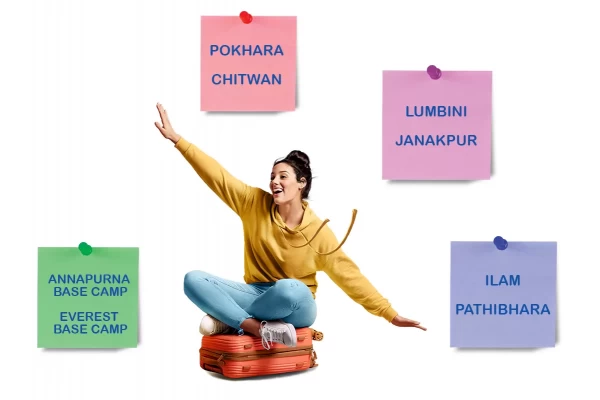
Buddha Air is stepping into its 25th anniversary after a quarter decade of connecting destinations in Nepal in a matter of an hour. We are immensely grateful to have served to make our beautiful Nepal easily accessible by air travel. Destinations are our prime goal to accomplish, and today, we stand proud to connect 15 destinations across the country.
These heartwarming destinations with breathtaking views of the mountains, serene sceneries among the hills, and the captivating life and culture of the Tarai give great potential for tourism in our country. On the occasion of flying for 25 years, we want to take this opportunity to appreciate the 25 most popular destinations of Nepal.
Kathmandu: Capita City and Home to World Heritage Sites
Kathmandu, the capital of Nepal, cannot be missed as a major tourist center. It is home to 4 heritage sites listed by UNESCO; Kathmandu Durbar Square, Boudha, Pashupatinath, and Swayambhu. In Kathmandu Durbar Square, the palace area, there are ancient temples, palaces, and chowks where centuries-old artifacts dating back to the Malla period can be found. Close to the Durbar square area, there is the Narayanhiti Palace Museum, Singha Durbar, and Thamel. Likewise, the Boudha stupa is a 36-meter tall ‘Mahachaitya’. The mandala-shaped chaitya is believed to have been built in the fifth century by King Mandev I (AD 464-505). The surroundings of the stupa are popular for the preservation of Tibetan and Himalayan cultures and are spotted with Buddhist monasteries and Tibetan eateries.
 In 1979, UNESCO listed Pashupatinath, the temple of the Hindu God, as a World Heritage Site. Pashupatinath is considered to be the guardian of all living beings. It is the symbol of success, religion, meaning, work, and salvation. Pashupatinath Temple is located in Devpatan, Kathmandu. There are temples of various gods and goddesses in the Pashupatinath area. It is a major religious destination for Hindus. The holy Bagmati river also flows beside the premises of the Pashupatinath temple. UNESCO also listed Swayambhunath as a World Heritage Site in 1979.
In 1979, UNESCO listed Pashupatinath, the temple of the Hindu God, as a World Heritage Site. Pashupatinath is considered to be the guardian of all living beings. It is the symbol of success, religion, meaning, work, and salvation. Pashupatinath Temple is located in Devpatan, Kathmandu. There are temples of various gods and goddesses in the Pashupatinath area. It is a major religious destination for Hindus. The holy Bagmati river also flows beside the premises of the Pashupatinath temple. UNESCO also listed Swayambhunath as a World Heritage Site in 1979.
In Sanskrit, the word ‘Swayambhu’ means the land of self-origin. According to Buddhist mythology, the giant stupa is said to have originated by itself after Manjushree, the god of wisdom and knowledge drained the water from the lake which was Kathmandu valley. Besides the stupa, other attractions in Swayambhu include Pratappur Temple, Harati Temple, Buddhist Museum, Buddha Park, etc.
The best time to visit Kathmandu is from September to December when the monsoon rains have cleared and the blue sky and the mountains are visible.
Pokhara: Tourism Capital of Nepal
Pokhara is the trinity of nature, culture, and adventure activities. This valley is a jewel to our country because of its alluring Mountain views, breathtaking lakes, caves, temples, monasteries, rivers, and waterfalls. Paragliding, bungee-jump, canyoning, and zip lining are some of the most popular adventurous activities one comes to experience here. Thousands of tourists come here to witness the majestic Annapurna range, from Dhaulagiri, Machhapuchchre, PutthaNitchuli, and Annapurna, to Nitchuli, Nilgiri, Mardi, Lamjung, and Manaslu. There are nine lakes in the valley; Phewa Lake, Begnas Lake, Kamal Lake, Rupa Lake, Khaste Lake, Dipang Lake, Gunde Lake, Maidi Lake, and Newreni Lake.
There are also many caves - Mahendra Cave, Chamere Cave, Gupteshwar Cave, and many more. Davis Falls can be seen from Gupteshwar Cave. Similarly, the Seti River flowing underground is another attraction of Pokhara. Seti River and Phewa Lake are also popular for Kayaking. There are half a dozen museums in Pokhara. The Himalayas, forests, and rural life can be observed from the hills like Kahunkot, Sarangkot, Pumdikot, Anadu, Dhampus, Lumle, Sikles, Lwanghalel, Tangting, Nirmalpokhari, Bharatpokhari, Hemjakot, Astam, and Sundaridanda. Pokhara is also the gateway to Annapurna Circuit, Panchase, Annapurna Base Camp, Mardi Base Camp, Dhaulagiri Round, and many more. Pokhara is also known as a resort city full of convenient hotels and resorts. The valley is inhabited by Gurung, Magar, Kshatriya, Bahun, Thakali, and Newar. Pokhara can be visited throughout the year.
The best time to visit Pokhara is from October to January.
How to Reach Pokhara?
Distance between Kathmandu and Pokhara is 200 km, and it takes around 6 hours by bus. Buses and microbuses depart from Kalanki in Kathmandu early in the morning. Daily Flights from Kathmandu to Pokhara are also available for your better convenience that takes only 25 minutes to travel.
Chitwan: Rich in Biodiversity
Chitwan National Park is the first and oldest national park in Nepal. This park was listed as a UNESCO World Heritage Site in 1984 and covers an area of 367.81 square miles. Rich in biodiversity, it is located in the Central Terai of Nepal. The destinations inside the central area of the park include Sauraha, Meghauli, Patihani, Kasara, and Amaltari. About 121 tigers are living in the park. The park is also famous for one-horned rhinoceros, elephants, and various species of birds. Jungle safaris are the most popular and enjoyable activity in the park along with canyoning, jungle walking, and elephant safari.
Destinations in the buffer-zone area offer an experience of the Tharu culture as well. There is also a Tharu museum here that the tourists can enjoy. Hotel Association Chitwan organizes an elephant festival every year during the months of November to January. At that time, exciting activities such as elephant camp football, elephant picnic, and elephant beauty pageants are conducted.
The best time to visit Chitwan is from October to January and from February to June.
How to Reach Chitwan?
Distance between Kathmandu and Sauraha, Chitwan is 165 km. Daily Flights from Kathmandu to Bharatpur are also operated that takes around 25 minutes to travel. To reach Sauraha, Chitwan from Bharatpur, it takes around 20 minutes by vehicle.
Janakpur: Rich in Religious Heritage and Mithila Art
Janakpur in the Dhanusha district is a city rich in Mithila art and filled with ancient temples, pools, and ponds. According to the Hindu text Ramayana, Janakpur is the birthplace of King Janak and Sita. It is an important religious heritage for Hindus. The Janaki Temple is the main attraction of this ancient city. Inside the temple, which looks like a palace, there are idols of God Vashishtha, Satyananda, Sunayana, Ram, Lakshman, Bharat, Shatrughan Ram, Sita, and Janak. According to history, Queen Bhanu Vrishkumari of Tikamgarh, India took a vow here, and her son was born. Then the queen ordered the building of the glorious Temple. Next to the Janaki temple is the marriage hall where it is believed that Ram and Sita got married. There is also a Janaki museum inside the temple.
 There are numerous lakes in the area, namely Gangasagar, Dhanushsagar, and Ratnasagar. Aarti, the mesmerizing Hindu practice of offering light is performed on the banks of these lakes every evening. Many fairs take place regularly, close to the temple.
There are numerous lakes in the area, namely Gangasagar, Dhanushsagar, and Ratnasagar. Aarti, the mesmerizing Hindu practice of offering light is performed on the banks of these lakes every evening. Many fairs take place regularly, close to the temple.
October to November and February to March is the best time to visit Janakpur.
How to Reach Janakpur from Kathmandu?
The distance from Kathmandu to Janakpur via Mugling is 350 km. and via Banepa- Bardiwas road is 210 km. Flights from Kathmandu to Janakpur takes 25 minutes to travel.
Lumbini Garden: Birthplace of Gautam Buddha
The birthplace of Gautam Buddha, the pioneer of Buddhism, the Lumbini Garden is yet another popular tourist destination in Nepal. It covers an area of 7.6 square kilometers and within it lies numerous temples, international monasteries, and ancient palace ruins. According to history, Buddha was born here in 623 BC to his mother, Maya Devi near the Pushkarini pond. Today, there is a temple built at this site called the Maya Devi temple.
There is also a canal that passes through the entire length of the garden allowing visitors to commute smoothly from one end of the garden to another. It is a peaceful environment with the sound of devotees and monks chanting prayers and meditating. Other places to visit outside the Lumbini garden include Ramgrama, Kapilvastu Darbar, Kudan, Niglihwa, Gotihwa, Sagrahwa, and Jagdishpur Lake.
The best time to visit Lumbini is from October to November and from February to March.
How to Reach Lumbini from Kathmandu?
Lumbini is 325 km away from Kathmandu. It takes around 9 hours by bus from Kathmandu to Lumbini. You can also take flights from Kathmandu to Bhairahawa that takes around 25 minutes. From Bhairahawa, Lumbini is 20 km away, which can be traveled by bus.
Annapurna Base Camp (ABC)
The Annapurna Base Camp (4,130m) sits on the bowl-shaped southern side of Annapurna-1. It is surrounded by the Annapurna snow range, Gangapurna South and Annapurna East. Annapurna is the first mountain to be summited among all the 8,000-meter mountains in the world by French citizens Maurice Herzog and Louis Lachenal on June 3, 1950.
 The ABC trail is part of the Annapurna Conservation Area Project (ACAP) which starts from Ghandruk village, passing through wild Rhododendron forests, hot-water streams, captivating waterfalls, and peaceful villages, and ends in the peaceful village of Tilche. The mountains stand at their most beautiful when the golden rays of the setting sun reflect on the snow giving a breathtaking sunset and sunrise experience. There are also ridges and glaciers at the foot of the mountains with frozen rivers and lakes.
The ABC trail is part of the Annapurna Conservation Area Project (ACAP) which starts from Ghandruk village, passing through wild Rhododendron forests, hot-water streams, captivating waterfalls, and peaceful villages, and ends in the peaceful village of Tilche. The mountains stand at their most beautiful when the golden rays of the setting sun reflect on the snow giving a breathtaking sunset and sunrise experience. There are also ridges and glaciers at the foot of the mountains with frozen rivers and lakes.
October to November is the best time to trek the ABC.
How to Reach Annapurna Base Camp (ABC)?
Take a 25-minute flight or a 6-hour car ride to reach Pokhara from Kathmandu. 67 km from Pokhara to Ghandruk via Nayapul. Annapurna base camp is a four days trek from Ghandruk. You can also ride a helicopter from Pokhara.
Ilam: Agro-tourism Destination
Green and luscious tea gardens blanketing the eastern hills–Ilam is an agro-tourism destination. Ilam Bazaar (1,208m), the headquarters of the district, bustles with life that tourists ever-so enjoy exploring. Right above it lies Nepal’s first tea gardens where more than 55,000 hectares of land is covered by tea shrubs. There are a handful of places to visit in and around Ilam. The View Tower, Bear Stone Cave, Chureghanti Monastery, Narayansthan, Maisthan, Bhimsensthan, Tea factories, Sinhavahini, Setidevi temple, and many more are some of the most popular sites here.
Ilam offers a fantastical view of the tea gardens spanning towards the horizon, blending in with specs of ground fog in the mornings and evenings. From March to November, one can witness tea leaf pickers working in the fields. Kanyam, Antu Danda, Sandakpur, Maipokhari, Chintapu, Miklajong, Todke Jharna, Mangmalung, Siddhi Thumka, Gajurmukhi, Maikhola, Pathibhara, and Targade and are other worth-visiting destinations.
 About 20 km from the Ilam Bazaar lies the settlement of the Lapcha tribe at a village called Fikkal. There is Lapcha museum and Lapcha monastery nearby. Sandakpur (3,636m) is 42 km from Ilam Bazaar on the border of Nepal and Darjeeling, India. This hill station overlooks the alluring easter Himalayan range, from Mt Makalu, Kumbhakarna, and Kanchenjunga to Mt Everest.
About 20 km from the Ilam Bazaar lies the settlement of the Lapcha tribe at a village called Fikkal. There is Lapcha museum and Lapcha monastery nearby. Sandakpur (3,636m) is 42 km from Ilam Bazaar on the border of Nepal and Darjeeling, India. This hill station overlooks the alluring easter Himalayan range, from Mt Makalu, Kumbhakarna, and Kanchenjunga to Mt Everest.
March to November is the best time to visit Ilam.
How to reach Ilam?
Distance between Kathmandu to Ilam Bazaar is 690 km by bus. You can also choose to take flights from Kathmandu to Bhadrapur that can be reached by 45 minutes. The distance from Bhadrapur to Ilam is 95 km, and Ilambazar-Sandakpur is 42 km.
Everest Base Camp
To the lap of the tallest mountain in the world, the EBC trek starts from Lukla (2,860m) and follows through Phakding, Namche, Syangboche, Tengboche, Dingboche, Lobuche, and Pangboche. Tourists spend two nights at Namche Bazaar to get comfortable with the altitude. Namche offers a beautiful view of Mt Kongde Chuli, Mt Thamserku, and Mt Amadablam. The accommodations found on this trail are mostly of high-quality thanks to the high influx of tourists here.
 The EBC trail diverges towards two routes, from Gorakshep (5,100m), and Kalapathar (5,600m). Some tourists choose the Base camp route, while some climb towards Kalapathar, one of the best spots for a 360-degree view of the Himalayas. The trek is filled with wild cliffs and Buddhist scriptures carved on the rocks. Trekkers also come across two rivers, Dudhkoshi and Khare.
The EBC trail diverges towards two routes, from Gorakshep (5,100m), and Kalapathar (5,600m). Some tourists choose the Base camp route, while some climb towards Kalapathar, one of the best spots for a 360-degree view of the Himalayas. The trek is filled with wild cliffs and Buddhist scriptures carved on the rocks. Trekkers also come across two rivers, Dudhkoshi and Khare.
October to November is the best time to visit the Everest base Camp.
How to Reach Everest Base Camp?
Kathmandu to Manthali is 140 km, and it takes four hours by bus. Manthali to Lukla is 15 minutes of air travel. EBC can be reached on the eighth day of the trek from Lukla. On the way back, you can reach Kathmandu in four days.
Langtang
The Langtang Valley and Kengzhen Valley (3,900m), which lie right above it, are rich in Tamang culture and Buddhism. Both are situated inside the Langtang National Park, Rasuwa surrounded by the serene peaks of Langtang Lirung, Dorjelakpa, Yala Peak, Jugal, and Gangchempo. The National Park is named after its signature sight, Langtang Himal (7,246m), and the Langtang river flows from the foot of this mountain. Just two hours uphill from the valley sits the snow-covered Mt Cherkori (4,984m). Right above Kangzhen Valley is the Yala Peak (5,500m) where mountaineers train.
From Syafrubesi, Rasuwa, a three-day trek takes you to Kangzhen Valley through Langtang village. You have to go uphill along the banks of the Langtang river. This trail passes by Tamang community settlements and ancient monasteries.
October to November is the best time for Langtang trekking.
How to Reach Langtang from Kathmandu?
Distance from Kathmandu to Syafrubesi is 132 km, and it takes around 6 hours by jeep. Kangzhen Valley is a three-day trek from Syafrubesi.
Mardi Base Camp
The Mardi Himal trekking route is perfect for those who don’t have enough time to trek to Annapurna Base Camp or Everest Base Camp, but still want to experience trekking in the Himalayas. The trail is abundant in majestic sceneries of the mountains and warm encounters with the local people. Mardi Himal (5,587 m) is located in the Kaski district, right beside Mt Machhapuchhre. It lies at an altitude of 4,250 meters, and the trail is surrounded by the majestic Mt Annapurna South, Himchuli, Annapurna First, Singchuli, Tent Peak, Gangapurna, and Gandharva Chuli.
 There are two routes to Mardi. One from Kade, Kaski, through Hemja and Ghalel village where the first stop of the trek is at Low Camp (2,985m). The next day, one can trek until the High Camp (3,540 m). Mardi base camp is reached in four hours from the high camp. On the way back from the trek, there is an opportunity to go canyoning in the Kudi river of Ghalel village. There, Pokhara Canyoning offers canyoning in a 45-meter-long waterfall. The Gurung community lives on the foot of the Ghalel Village. Right by the Ghalel village sits Lwang village, where one can enjoy the serene tea gardens and experience canyoning and even paragliding.
There are two routes to Mardi. One from Kade, Kaski, through Hemja and Ghalel village where the first stop of the trek is at Low Camp (2,985m). The next day, one can trek until the High Camp (3,540 m). Mardi base camp is reached in four hours from the high camp. On the way back from the trek, there is an opportunity to go canyoning in the Kudi river of Ghalel village. There, Pokhara Canyoning offers canyoning in a 45-meter-long waterfall. The Gurung community lives on the foot of the Ghalel Village. Right by the Ghalel village sits Lwang village, where one can enjoy the serene tea gardens and experience canyoning and even paragliding.
October to November is the best time for Mardi trekking.
How to Reach Mardi Base Camp?
Time duration from Kathmandu to Pokhara by bus is 6-7 hours or Kathmandu-Pokhara is 25 minutes by air. Pokhara-Ghalel 22 km. Pokhara-Hemza 8 km. Hemja-Ghalel 14 km. High camp on the second day from Ghalel. Mardi base camp can be reached on the third day.
Poonhill, Myagdi
Poonhill (3,210m) is a hill station located in the Myagdi District under the Annapurna Conservation Area Project (ACAP). It offers a breathtaking panoramic view of the mountain range including Dhaulagiri, Annapurna, Macchapucchre, and Lamjung. The scenery looks its best during sunrise and sunset. The area is inhabited by the Pun community, and therefore, the hill is called Poonhill.
 The ideal way to travel to Poonhill is via Ghandruk (2,020m), a village inhabited by the Gurung community. Ghandruk is a beautiful village sitting amidst the hills and the mountains, covered with stone houses, rhododendron plants, and terrace farms. The trail is known for its natural beauty and the friendly, hospitable people who love to share their culture. To get to Poonhill from Ghandruk, you can take a jeep to Ghodepani from Pokhara via Nayapul, Teekhedhunga, and up to Ulleri. There is also the ‘Karbakeli Padmarg’ which descends to Benibazar from Poonhill passing the Karbakeli temple.
The ideal way to travel to Poonhill is via Ghandruk (2,020m), a village inhabited by the Gurung community. Ghandruk is a beautiful village sitting amidst the hills and the mountains, covered with stone houses, rhododendron plants, and terrace farms. The trail is known for its natural beauty and the friendly, hospitable people who love to share their culture. To get to Poonhill from Ghandruk, you can take a jeep to Ghodepani from Pokhara via Nayapul, Teekhedhunga, and up to Ulleri. There is also the ‘Karbakeli Padmarg’ which descends to Benibazar from Poonhill passing the Karbakeli temple.
October to November and February to April are the best times to visit Poonhill.
How to Reach Poonhill?
Kathmandu-Pokhara 200 km (6-7hours by vehicle). Kathmandu-Pokhara 25 minutes air travel. 39 km from Pokhara to Nayapul via Baglung highway. Nayapul-Ghandruk 21 km. Buses and jeeps are going towards Ghandruk from the old Tundikhel of Pokhara. Ghodepani can be reached by a 10-hour walk from Ghandruk.
Manang
The serene beauty of the mountains, unique geography and the rich Bhote culture are the main attractions of Manang (3,540m). The hidden village is located in the Annapurna Circuit Trek which starts from Besisahar and ends at Muktinath in Mustang. It is situated at the foothills of Gangapurna Lake, Tilicho Peak, Mt Gangapurna, and Mt Annapurna. Other attractions of Manang include Tilicho Lake, Nar and Phu villages, and the Thorung La pass. The villages lie on the banks of the Marshyangdi river. It takes three days to reach Tilicho Lake from here.
Manang welcomes tourists with its blend of the rocky Himalayan landscape and the settlements of stone and mud houses, with Buddhist mantras written on stone and colorful prayer flags fluttering around them. There is also a museum inside the village that houses displays like Muskrats, and Yaks as well as old weapons and ornaments of the ancient Ghale Kings.
 The mountains lay at their best during the winter season. But the route to Manang, however, is more adventurous during the monsoon, with wildflowers surrounding the pathway and breathtaking waterfalls filling up through the rocky hills and mountains. There are hotels on the Annapurna circuit up to Thorang Phedi (4,450m) and High Camp (4,850m). Tourists can climb Thorang Bhanjang (5,416 m) and then leave for Mustang from there.
The mountains lay at their best during the winter season. But the route to Manang, however, is more adventurous during the monsoon, with wildflowers surrounding the pathway and breathtaking waterfalls filling up through the rocky hills and mountains. There are hotels on the Annapurna circuit up to Thorang Phedi (4,450m) and High Camp (4,850m). Tourists can climb Thorang Bhanjang (5,416 m) and then leave for Mustang from there.
June-July and autumn are the best times to visit Manang.
How to Reach Manang?
Besisahar is 172 km from Kathmandu or 106 km from Pokhara. Manang village is 90 km from Besisahar.
Lo-Manthang, Upper Mustang
Lo-Manthang (3,850 m) is a valley situated in the upper-Mustang region. Located amidst the barren rocky geography between the Tibetan Plateau and the Himalayas, Mustang is considered a cold desert. The Upper Mustang region was restricted to tourists up until 1991, earning its name of the ‘mystical valley’. The bare mountains and the Kaligandaki river are some of the surreal attractions here. Thak Khola of Thakali Community, Jomsom market, Thini, Kagbeni, Muktinath temple, and Lo-Manthang area are some of the popular tourist destinations of Mustang.
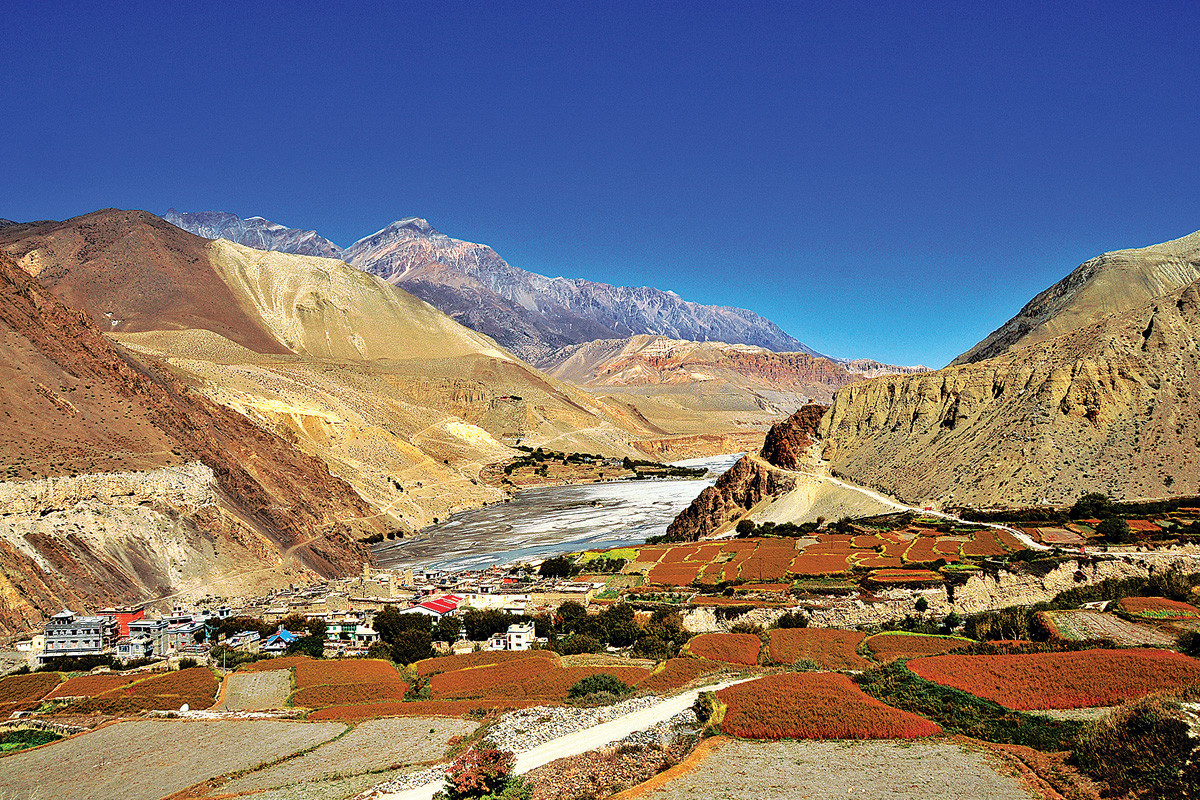 But the valley is best known for the Zhong Cave located in Choser. It is a ‘Cave village’ consisting of 108 rooms in a five-storey tall cave wall. The ‘rooms’ are decorated with age-old pottery and human skeletons. On the other side of Zhong is Nifug Monastery where there are Buddhist paintings and statues. The Tibetan border lies just 12 km from Lo-Manthang.
But the valley is best known for the Zhong Cave located in Choser. It is a ‘Cave village’ consisting of 108 rooms in a five-storey tall cave wall. The ‘rooms’ are decorated with age-old pottery and human skeletons. On the other side of Zhong is Nifug Monastery where there are Buddhist paintings and statues. The Tibetan border lies just 12 km from Lo-Manthang.
The best season to visit Mustang is October-November.
How to Reach Lo-Monthang, Upper Mustang?
Kathmandu-Pokhara-Beni 288 km. Beni-Jomsom 74 km. Jomsom-Muktinath 22 km. Jomsom-Lo-Manthang 90 km. Or, Kathmandu to Pokhara, 25 minutes via air travel. Jomsom is reached in 16 minutes by air from Pokhara.
Bhedetar
Located on the border of the Sunsari and Dhankuta districts, Bhedetar (1,420 m) is a famous hill station in eastern Nepal. It is home to heritage sites such as the statue of linguist Imansingh Chemjong, Shankheswar Mahadev, Charles Tower, Simsuwa (Namaste) Waterfall, Pathibhara Temple, and Namje Village. Zipline and paragliding are also done from here.The weather here is cool throughout the year. On days when the sky is clear, Everest, Makalu, and Kumbakarna can be seen. The famous Pathibhara temple and Sangurigadhi are only 3 km from the market. Similarly, 4 km from Bhedetar lies Namje, a beautiful Magar village. Also popularly phrased as ‘house where the soul resides’, Namje village is famous for a mass grave built by American architects by collecting the stones of 213 graves. It is believed that the ancestors of the Magar community were buried here, and it is called ‘Atma Basne Ghar’.
In 1984, British Crown Prince Charles visited Bhedetar. As the prince climbed the Shailung Hill, the locals started calling it ‘Charles Danda’. Right below Bhedetar, by the road that leads to Dhankuta, sits the Simsuwa (Namaste waterfall). This area is popular for canyoning.
The hill station was named Bhetedar as once upon a time, it was the place where sheep were kept. During the construction of the Dharan-Dhankuta road in the 1930s, sheep from Sankhuwasabha, Taplejung, Bhojpur, and other districts were brought to Dharan.
Bhedetar can be visited throughout the year. Although, March to July is the best time to beat the heat.
How to Reach Bhedetar?
Kathmandu-Dharan is 550 km by road and Kathmandu-Biratnagar is 35 minutes by air. Dharan-Biratnagar is 40 km, Dharan-Bhedetar 17 km. From Dharan to Bhedetar take a bus going to Dhankuta or Rajarani.
Bandipur
Bandipur (1,030 m) is a hill station that overlooks Dhaulagiri, Machhapuchchre, Annapurna, Lamjung, Manaslu, Himchuli, Ganesh, and Langtang mountains. Originally a Newar settlement, Bandipur resonates with the old-Bhaktapur vibe with its terracotta bricks, wooden-carved window sills, and antique doors. The main market area is paved with stone paths and aligned with old houses. The area is inhabited by Gurung, Magar, Newar, Kshatriya, and Bahun communities. A one-and-a-half-hour route from the market leads to the Bandipur Cave. It is about 425 meters in length and the width is up to 25 meters. There is a 57-meter-deep tunnel in the lower part and a set of narrow divisions and wide spaces inside the cave, making it fascinating for the tourists visiting Bandipur.
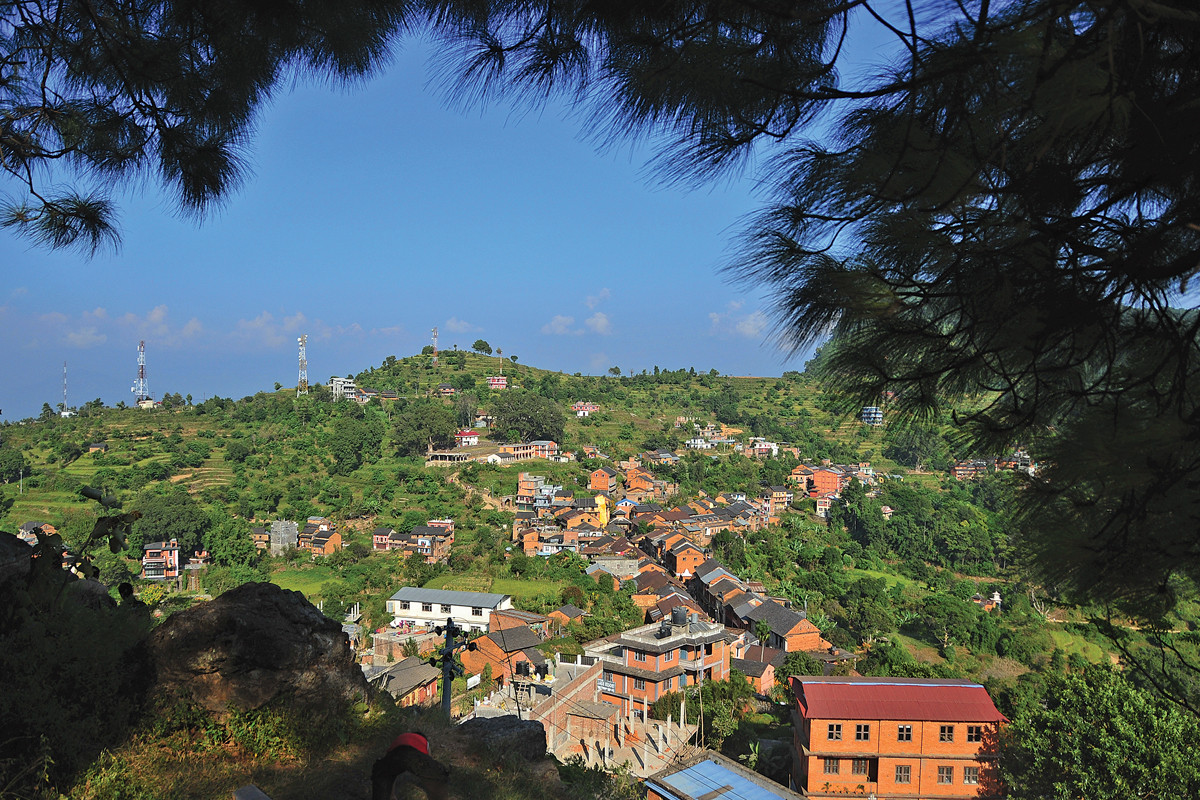 Bandipur has temples and monasteries including Vindhyavasini, Thanimai, Khadgadevi, Mahalakshmi, and Mahadev. There is also a martyr’s memorial on the top of the nearby hill. During the mornings, the fog covering Marshyangdi Valley almost looks like a ‘white lake’ from here.
Bandipur has temples and monasteries including Vindhyavasini, Thanimai, Khadgadevi, Mahalakshmi, and Mahadev. There is also a martyr’s memorial on the top of the nearby hill. During the mornings, the fog covering Marshyangdi Valley almost looks like a ‘white lake’ from here.
The Masryangdi River is famous for rafting, which is done from Paundi to Bimalnagar. Bimalnagar connected to the Prithvi Highway also offers rock climbing. Paragliding flights are also done here.
October to January is the best time to visit Bandipur.
How to Reach Bandipur?
Kathmandu-Mugling-Dumre-Bandipur (146 km). Or Kathmandu-Pokhara 25 minutes air travel. Bandipur is 76 km from Pokhara through the Prithivi Highway.
Swargadwari
Swargadwari (2,048m) is a religious pilgrimage site in the Pyuthan district. Myths recite that this land became Holy after Brahma performed penance here. According to the Hindu epic Mahabharata, the five Pandavas went to heaven from here. That is why it is called Swargadwari, 'the gateway to heaven. The area is blessed with natural beauty alongside its religious significance. It overlooks the heavenly mountain ranges from Dhaulagiri, Nilgiri, Machhapuchchre, Annapurna, Lamjung, Himchuli, Manaslu, Churen, and Putha.
There is a Yagyashala situated here. It houses the idols of the Panchayat Hindu gods, Ganesha, Surya, Vishnu, and Shiva. There is also a fire pit in the middle of a four-cornered room where smoke constantly comes out. Batuks perform rituals, Veda and Bhagwat reading, Havan and Rudrabhishek here.
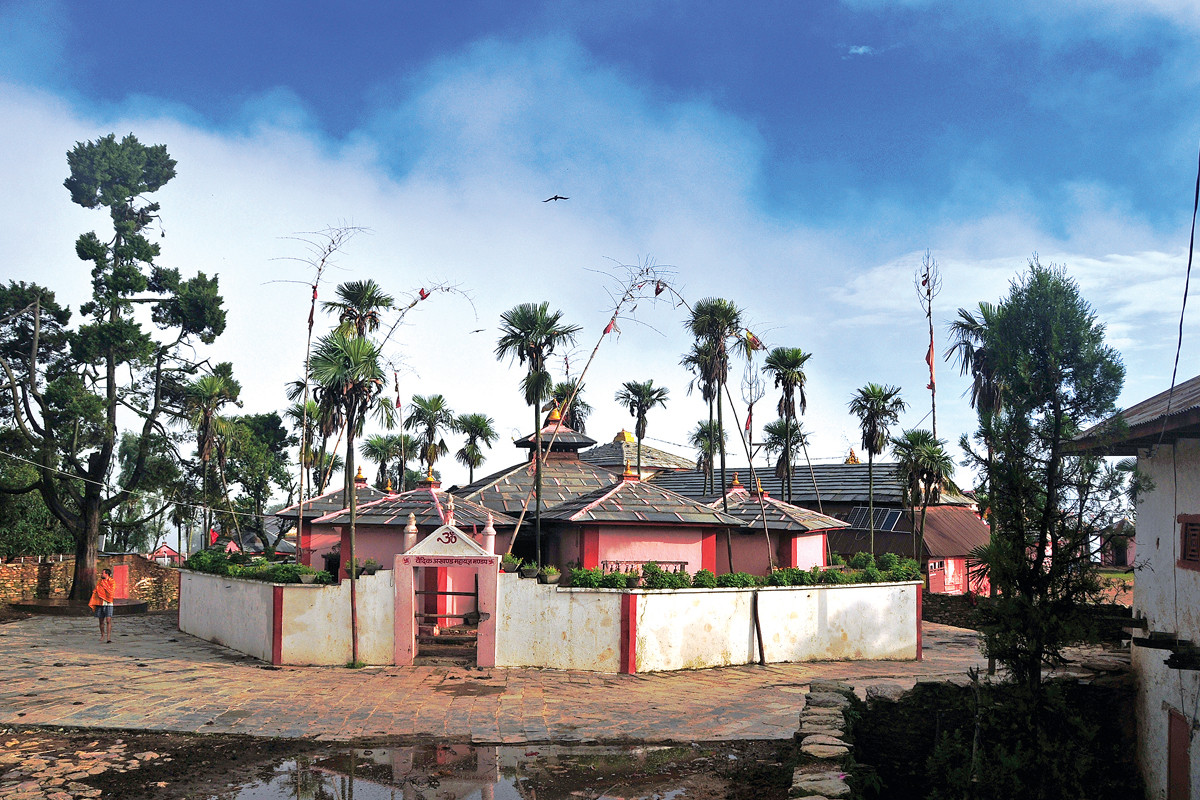 The temple area has common lodges and shops that sell offerings to the god as well as gift items. There are also some Dharamshalas near the temple.
The temple area has common lodges and shops that sell offerings to the god as well as gift items. There are also some Dharamshalas near the temple.
Best time to visit Swargadwari is from October to November and from March to June.
How to Reach Swargadwari ?
Kathmandu-Bhingri 420 km. Or Kathmandu-Bhairawa 25 minutes by air. Bhairahawa-Bhingri 185 km. Bhingri-Dharampani 13 km. Swargadwari is half an hours walking distance from Dharampani. Dharampani-Holeri distance is 29 km.
Manaslu
Mt. Manaslu (8163m) lies in the Nubri valley in Gorkha. The Manaslu trekking trail starts from Gorkha and passes through the Nubri and Tsum valleys, crossing the Larkya La Pass (5213m), and reaching Besisahar through Dharapani of Manang. The trial takes about two weeks to complete. It follows the classic salt-trade route along the Budhi Gandaki river. The trail consists of high pastures, Buddhist monasteries, and rocky terrains. The Manaslu Glacier Lake is the highlight of this trek and it looks beautiful from the Sayla and Lho villages of the Nubri Valley. Along this route, Cheo Himal, Himlung Himal (Nemjung), and Kang Guru are seen along with occasional views of the Annapurna Massif.
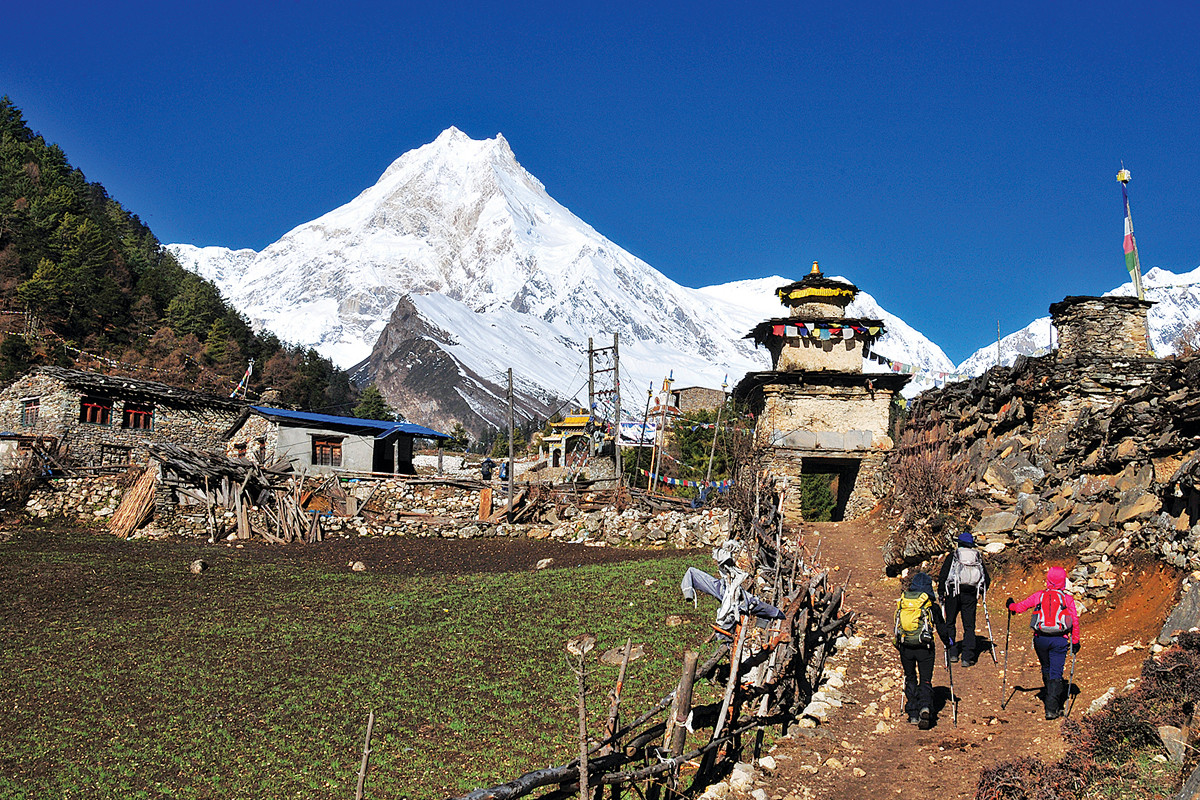 There are many Buddhist sites in Manaslu including the Milarepa cave, and Serang Gumba where it is believed that Guru Padmasambhava meditated. Manaslu Base Camp (4800 meters), takes six days of trekking from Soti Khola. Hotels and electricity are available throughout the trek. But at the Manaslu Base Camp, the hotel has no electricity.
There are many Buddhist sites in Manaslu including the Milarepa cave, and Serang Gumba where it is believed that Guru Padmasambhava meditated. Manaslu Base Camp (4800 meters), takes six days of trekking from Soti Khola. Hotels and electricity are available throughout the trek. But at the Manaslu Base Camp, the hotel has no electricity.
The best time to visit Manaslu is from mid-February to mid-June and from mid-September to mid-December.
How to Reach Manaslu?
By road, Kathmandu– Dhadingbeshi- Arughat is 122 km. Arughat-Soti is 12 km, via jeep. From Soti, it’s a six-day trek to Samagaun. Further, Samagaun to Manaslu Base Camp takes a day.
Pathibhara Temple, Tamplejung
The Pathibhara temple which lies at an altitude of 3,794m in Taplejung is revered as a powerful goddess. The statue of goddess Pathibhara lies on top of a hill, under the open sky. The hill is blessed with a panoramic view of Mt. Kumbhakarna, Kanchenjunga, and other peaks. The scene looks best during the months of September to November. This mystical place is popular with domestic and Indian tourists. The weather here is cold all year round, and it snows heavily from November to January.
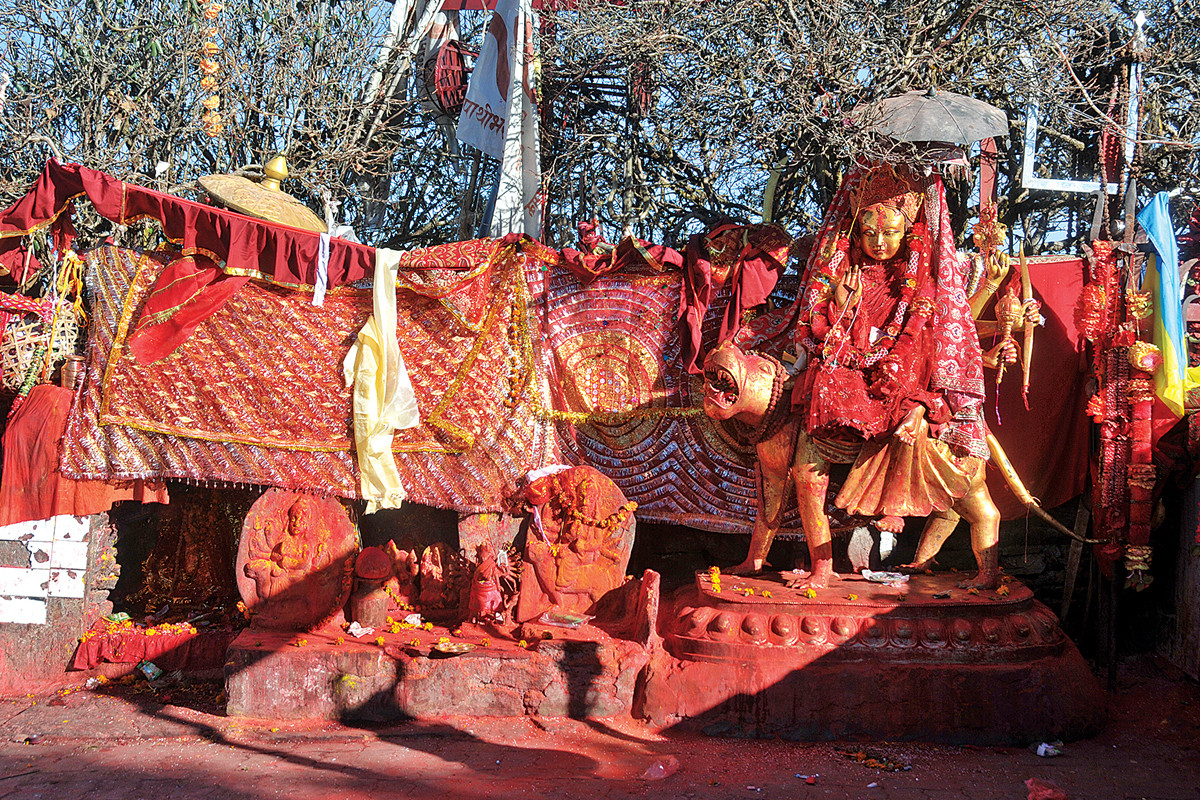 It is believed that Goddess Pathibhara is said to take away all the suffering and heal sickness. There is a tradition of hanging white thread around the temple to get one’s wishes fulfilled. This temple is also believed to grant a child to childless women and to grant prosperity and wealth to ones who desire it. Although there are eight ‘dharamshalas’ on the Pathibhara hill, pilgrims prefer to stay in the accommodations in the lower altitudes down in 'Phedi' due to the cold weather and scarcity of water.
It is believed that Goddess Pathibhara is said to take away all the suffering and heal sickness. There is a tradition of hanging white thread around the temple to get one’s wishes fulfilled. This temple is also believed to grant a child to childless women and to grant prosperity and wealth to ones who desire it. Although there are eight ‘dharamshalas’ on the Pathibhara hill, pilgrims prefer to stay in the accommodations in the lower altitudes down in 'Phedi' due to the cold weather and scarcity of water.
How to Reach Pathibhara Temple?
Kathmandu-Birtamod 506 km, 13 hours by bus. Birtamod-Phungling 237 km. Phungling-Suketar 8 km. Or Kathmandu-Suketar one-hour flight. There is a road from Suketar to Kaflepati (9.5 km). From there there is a big hill at 3 km, it takes two hours. 2 km from 'Thulo Fedi'. That is, after climbing for 3 hours, Pathibhara is reached.
Koshi Tappu Wildlife Sanctuary
Koshi Tappu Wildlife Sanctuary is an island surrounded by rivers, famous for its bird and wild buffalo (arna) habitat. You can find jeep safari, jungle walk, elephant safari, and boat rides throughout the sanctuary. The sanctuary covers around 175 square kilometers and is a captivating must-visit hidden destination of Nepal. Migratory birds from Siberia come here during winter. While various other native species of animals are found in the reserve along with 11 wild elephants. There is also a Tharu settlement in the Jamuwa village which runs homestays for accommodation.
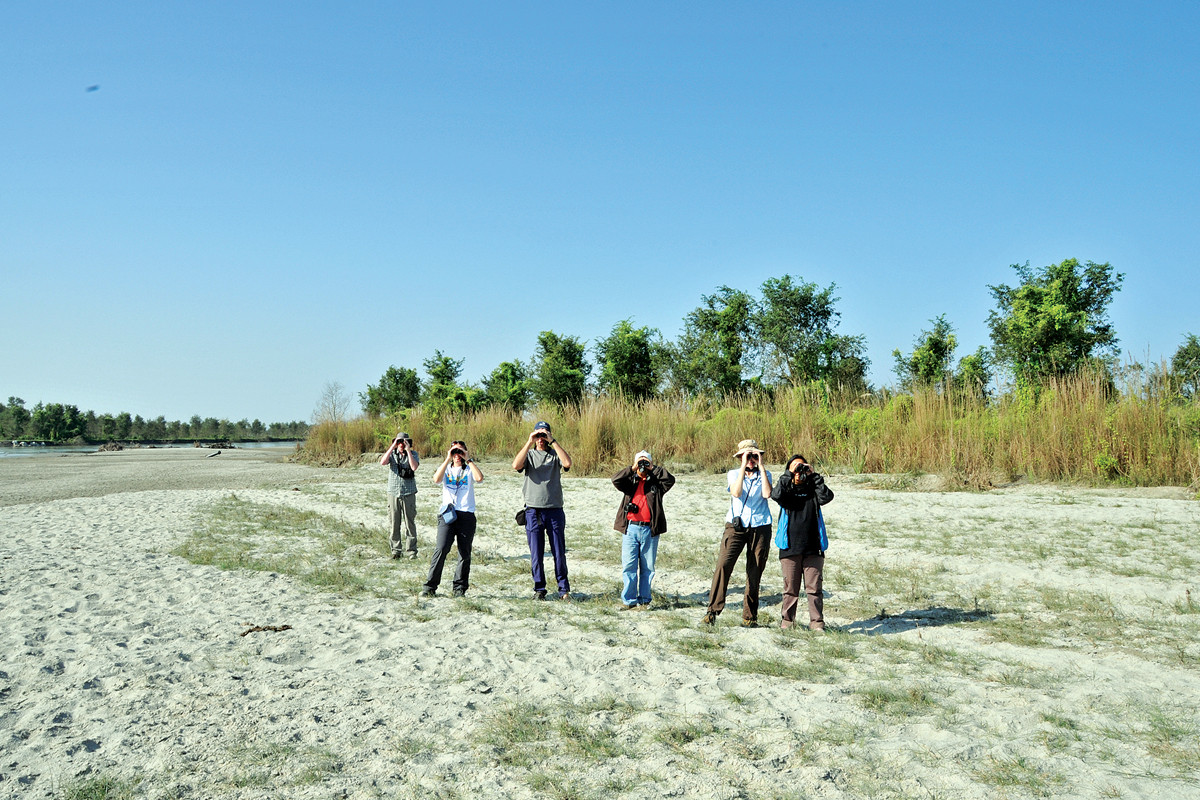 Similarly, there is a Tapeshwari intermediate community homestay in Udaypur. Other hotels can also be found in the central region of the sanctuary. On the outskirts of KoshiTappu, you can visit the Rautamai temple sitting on the lap of a hill. Rauta Pokhari takes a 10-minute uphill climb to reach. This pond is surrounded by dense rhododendron forests.
Similarly, there is a Tapeshwari intermediate community homestay in Udaypur. Other hotels can also be found in the central region of the sanctuary. On the outskirts of KoshiTappu, you can visit the Rautamai temple sitting on the lap of a hill. Rauta Pokhari takes a 10-minute uphill climb to reach. This pond is surrounded by dense rhododendron forests.
February to June is the best time to visit Kositappu.
How to reach Koshi Tappu?
Kathmandu-Koshi Tappu 500 km. Or Kathmandu- Biratnagar air travel 35 km. Biratnagar- Koshi Tappu is 47 km and takes one and a half hours by bus.
Bardiya National Park
Bardiya National Park is famous for its tigers. Currently, there are 125 tigers in the park. These tigers can be spotted during summertime near riverbanks. Visitors can travel through the park to spot the tigers and other wildlife via jeep safaris, and jungle walks. The park, spread over 968 sq km is home to 41 one-horned rhinoceros and more than 120 wild elephants. Similarly, there are 527 species of bird, and other animals such as chital, bear, wild boar, and nilgai.There is also an elephant breeding center at Thakurdwara, the headquarters of the park, and a Tharu museum along with the Thakur Baba temple.
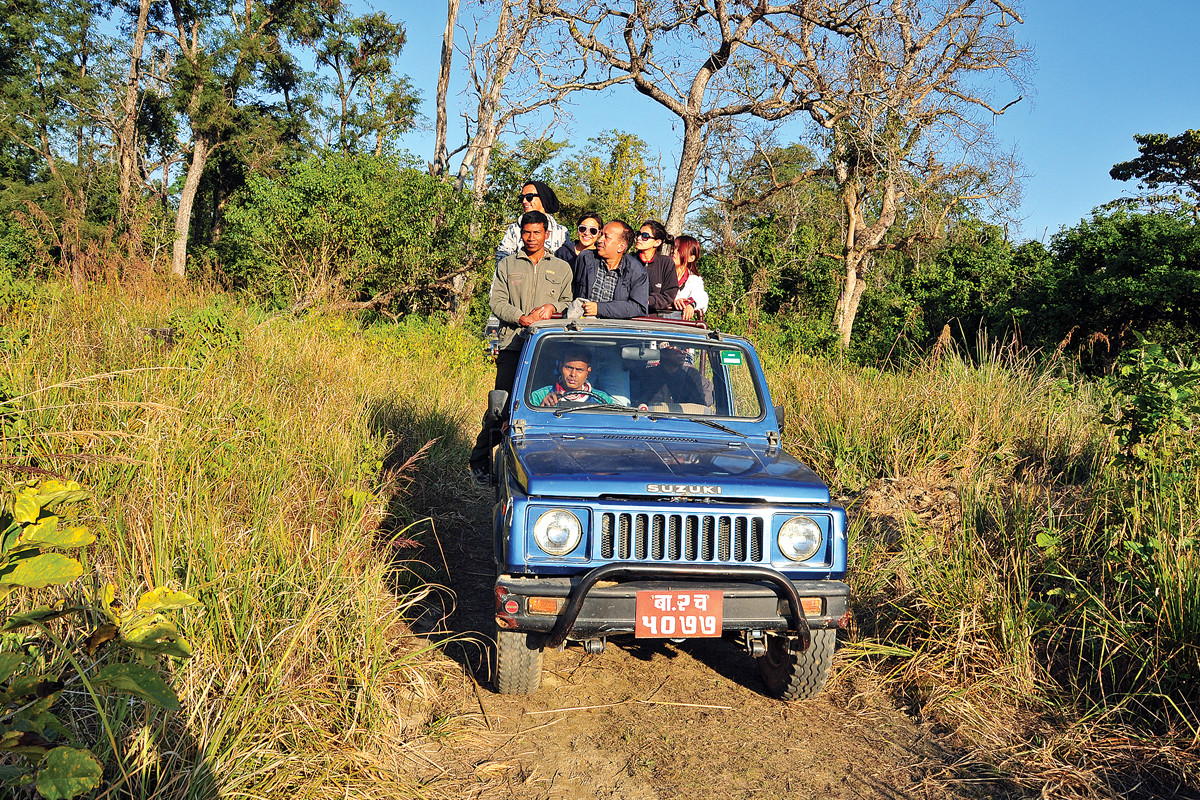 There is a popular belief that one’s wishes will be fulfilled by visiting Thakur Baba. You can also expect some adventure activities in the area as the park provides rafting facilities in the Karnali and Geruwa rivers. Fishing can also be done in Babai and Karnali rivers. One can also visit the Tharu communities on the outskirts of the park where homestays, hotels, and resorts are also available.
There is a popular belief that one’s wishes will be fulfilled by visiting Thakur Baba. You can also expect some adventure activities in the area as the park provides rafting facilities in the Karnali and Geruwa rivers. Fishing can also be done in Babai and Karnali rivers. One can also visit the Tharu communities on the outskirts of the park where homestays, hotels, and resorts are also available.
February to June is the best time to visit Bardia.
How to Reach Bardiya National Park?
Distance between Kathmandu and Nepalgunj is 500 km. Flights from Kathmandu to Nepalgunj takes around 1 hour to travel. By bus Nepalgunj- Ambasa- Thakurdwara (90 km). 13 km from Ambasa on the East-West Highway through Thakur, the headquarters of the park.
Suklaphanta National Park
Suklaphanta National Park is famous for its twelve-antlered deer. There are about 2,500 of these deer species spread over 55 square kilometers. The area goes through extreme drought from the months of December-January. Thousands of tourists visit every year to catch a glimpse of the deer and elephants grazing on the newly grown lotus buds after the drought. Travelers have remarked that the park provides an adrenaline-rushing, close encounter with the animals here.
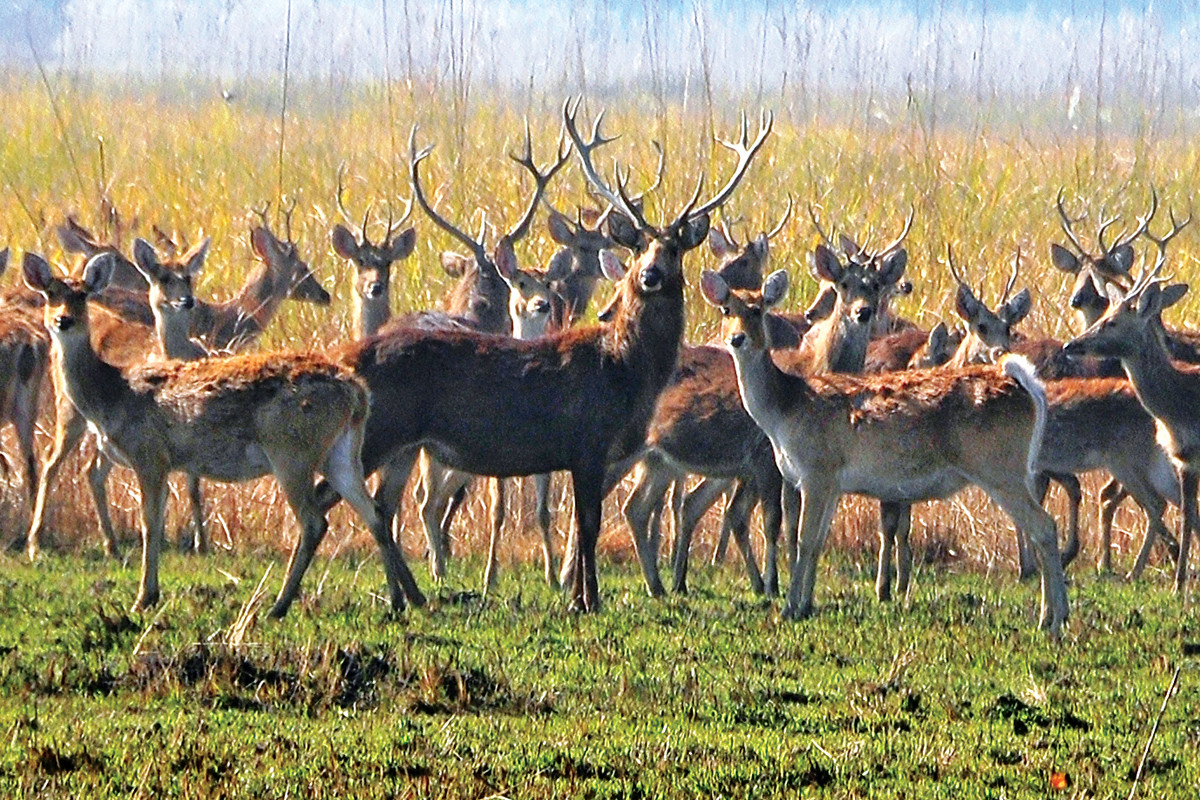 There are 53 species of mammals, 430 species of birds, 12 species of reptiles, 20 species of amphibians, and more than 35 species of butterflies in the Suklaphanta National Park. Besides the national park, you can visit Mahakali Bridge, Siddhababa Temple, Jhilmila Lake, Betkot Lake, Tanakpur Dam, and Mahakali River around its outskirts. Suklaphanta is located five kilometers west of Mahendranagar, where you can find hotels and other accommodations.
There are 53 species of mammals, 430 species of birds, 12 species of reptiles, 20 species of amphibians, and more than 35 species of butterflies in the Suklaphanta National Park. Besides the national park, you can visit Mahakali Bridge, Siddhababa Temple, Jhilmila Lake, Betkot Lake, Tanakpur Dam, and Mahakali River around its outskirts. Suklaphanta is located five kilometers west of Mahendranagar, where you can find hotels and other accommodations.
The best time to visit Shuklaphanta is from February to June.
How to Reach Suklaphanta?
Kathmandu- Mahendranagar 700 km. Or you can reach Dhangadhi from Kathmandu by air flight of 1 hour and 10 minutes. Dhangadhi- Mahendranagar 55 km, one hour by bus. Suklaphanta National Park is 5 kilometers away from Mahendranagar.
Tikapur, Karnali
Tikapur of Kailali is famous for its great garden where King Mahendra had taken a retreat after falling ill. It is said that when King Mahendra was hunting in Suklaphanta, he got a severe headache for which the private doctor suggested resting on the Karnali shore. The serene forest and the beautiful weather cured him. Later, he founded the ‘Mahendra Aarogya Griha’ which was called the ‘King’s retreat’. The government then provided a large area of land for the garden. Today, the garden is spread over 84 hectares with diverse plants, trees, and birds.
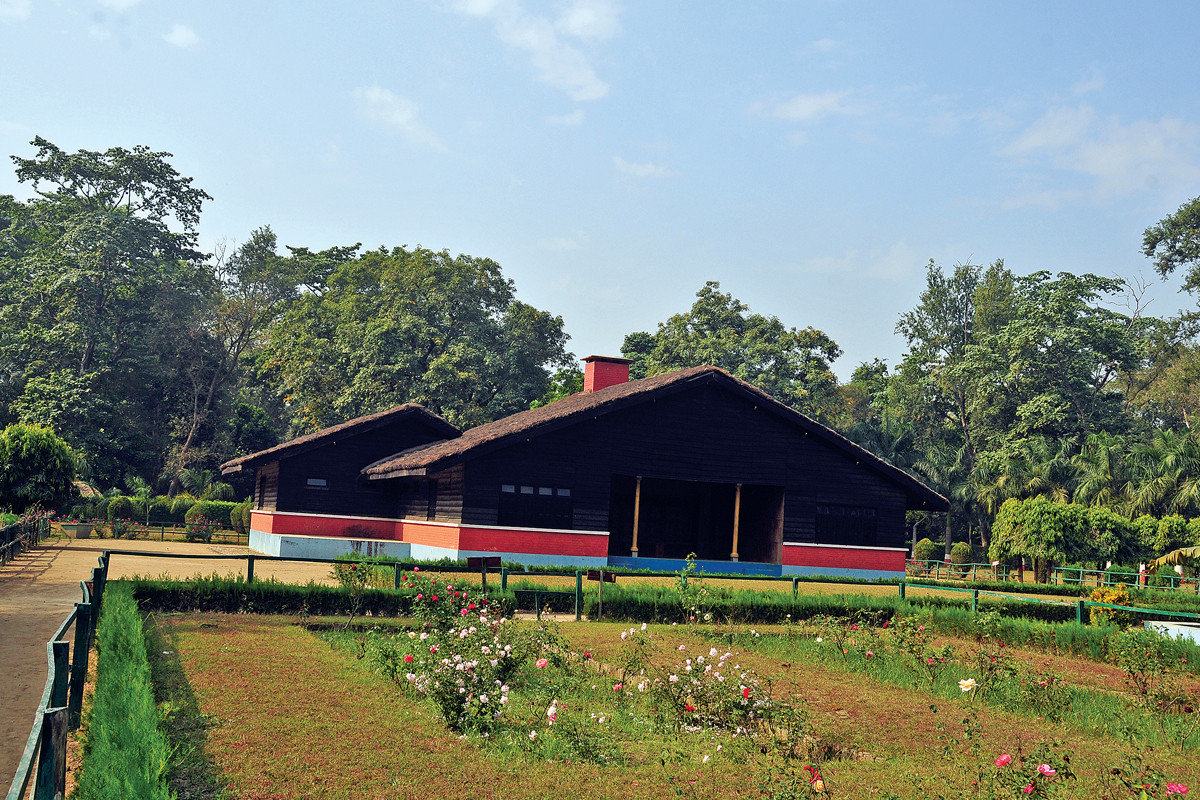 While Tikapur is a well-settled city on the banks of the Karnali river. Tikapur is also known for its banana plantations and a resort called ‘Rani Mahal’ offers over four dozen banana dishes. The dishes range from banana momos to wine. The owner, Kalu Hamal stands as an inspiration for showing how a farmer’s garden can be turned into an attractive resort. Besides these activities, you can also go rafting in the Karnali river in Tikapur.
While Tikapur is a well-settled city on the banks of the Karnali river. Tikapur is also known for its banana plantations and a resort called ‘Rani Mahal’ offers over four dozen banana dishes. The dishes range from banana momos to wine. The owner, Kalu Hamal stands as an inspiration for showing how a farmer’s garden can be turned into an attractive resort. Besides these activities, you can also go rafting in the Karnali river in Tikapur.
October to June is the best time to visit Tikapur.
How to Reach Tikapur?
Kathmandu- Tikapur 690 km. Buses run from Kathmandu to Tikapur. Tikapur is 18 km from Lamki on the EastWest highway. Or Kathmandu-Dhangadhi can be reached by 1 hour and 10 minutes flight. The distance from Dhangadhi to Tikapur is 90 km.
Bhaktapur Durbar Square
The Bhaktapur Durbar Square and Changunarayan Temple in the cultural city of Bhaktapur are listed on the UNESCO World Heritage List. This heritage site is famous for its historical architecture, temples, museums, and old alleys. Some of them include Chardham Temple, Pachpanna Jhyale Durbar, Taleju Bhawani, Nyatapol, Dattātreya, Peacock Window, Pujari Math, Siddhapokhri, Art Museum, and others.
Newari lifestyle, old houses, and narrow streets are the characteristics of Bhaktapur. Visiting here will make you feel as if you have traveled back in time. This old city still makes pottery and utensils by hand. Earthenware is made in the city’s Pottery Square, while wooden ones are made in the Dattatray area.
 Another important heritage of Bhaktapur is Changunarayan Temple. Sitting on a small hillock, the pagoda-style temple is one of the finest examples of this architecture. The temple has artistic doors in all four directions and images of deities carved on the walls and roofs of the temple. You can view the Sankhu area of Kathmandu and the Bhaktapur market area from here. Hotels, resorts, and restaurants are open for tourists in the Bhaktapur Durbar area, Thimi, Nagarkot, Ranikot, and Anantalingeshwar areas.
Another important heritage of Bhaktapur is Changunarayan Temple. Sitting on a small hillock, the pagoda-style temple is one of the finest examples of this architecture. The temple has artistic doors in all four directions and images of deities carved on the walls and roofs of the temple. You can view the Sankhu area of Kathmandu and the Bhaktapur market area from here. Hotels, resorts, and restaurants are open for tourists in the Bhaktapur Durbar area, Thimi, Nagarkot, Ranikot, and Anantalingeshwar areas.
How to Reach Bhaktapur?
Bhaktapur Durbar Square is 11 km from Kathmandu’s Tribhuvan International Airport and Changunarayan is 16 km away. You can reach Bhaktapur via taxi or public transportation.
Patan Durbar Square
The ancient city of Patan is a repository of ancient art and Newa culture. It is home to ancient temples, palaces, and museums. Many heritages date back to the sixteenth century. In the center of Patan, the Patan Durbar Square is an old palace premise that now houses a museum. Among other attractions, there are Mul Chowk and Sundari Chowk.
 Outside the palace are significant temples such as the Manikeshavanarayan Chowk, Vishwanath Temple, Bhimsen Temple, Krishna Temple, Taleju Temple, Kumbheshwar, and Hiranyavarna Mahabihar. A slow-paced and charming city, Patan is also known for preserving its art and heritage. So you will find many traditional arts, from painting and stone carving to repousse art and hand-crafted jewelry. There are typical Newar settlements like Khokana, Bungmati, and Siddhipur in the outskirts of Patan. Similarly, there are beautiful areas such as Godawari, Dalchoki, Bhattedanda, Devichaur, and Bhardeu suitable for hiking nearby. Hotels, restaurants, resorts, and homestay facilities are available near Patan Durbar Square. Patan area is also famous for Newari dishes.
Outside the palace are significant temples such as the Manikeshavanarayan Chowk, Vishwanath Temple, Bhimsen Temple, Krishna Temple, Taleju Temple, Kumbheshwar, and Hiranyavarna Mahabihar. A slow-paced and charming city, Patan is also known for preserving its art and heritage. So you will find many traditional arts, from painting and stone carving to repousse art and hand-crafted jewelry. There are typical Newar settlements like Khokana, Bungmati, and Siddhipur in the outskirts of Patan. Similarly, there are beautiful areas such as Godawari, Dalchoki, Bhattedanda, Devichaur, and Bhardeu suitable for hiking nearby. Hotels, restaurants, resorts, and homestay facilities are available near Patan Durbar Square. Patan area is also famous for Newari dishes.
How to Reach Patan Durbar Square?
Patan Durbar area is located 7 km from Tribhuvan Airport in Kathmandu. Taxis and public transportation are easily available.
BhoteKoshi: Famous for Adventurous Sports
One of the 5 major rivers of Nepal, the Koshi river system includes tributaries such as SaptaKoshi, BhoteKoshi, Indravati, DudhKoshi, Sunakoshi, Tamakoshi, Arun, and Tamor rivers. BhoteKoshi is a popular destination for whitewater rafting and thousands of tourists come here every year to enjoy the thrilling adventure. BhoteKoshi ranks seventh among the top ten rivers to raft in the world. Bhotekoshi offers all types of rafting packages from a day tour to several days of rafting. You can go rafting from Borderland to Jure falls. In the lower section, it can be done from a long narrow dam to Chatra. Similarly, the Tamakoshi river nearby is also known for kayaking. Rafting is done in the Arun River as well from Chumlingtar to Chatra.

Bhotekoshi is also famous for other adventure sports including Nepal’s first bungee jumping, swinging, and cannoning.
The best time to visit BhoteKoshi is from June to August during the monsoon in Nepal when the rapids are at their wildest.
How to reach BhoteKoshi ?
Kathmandu- Bhotekoshi is about 90 km. It takes about 3.5 hours by bus to reach there.
